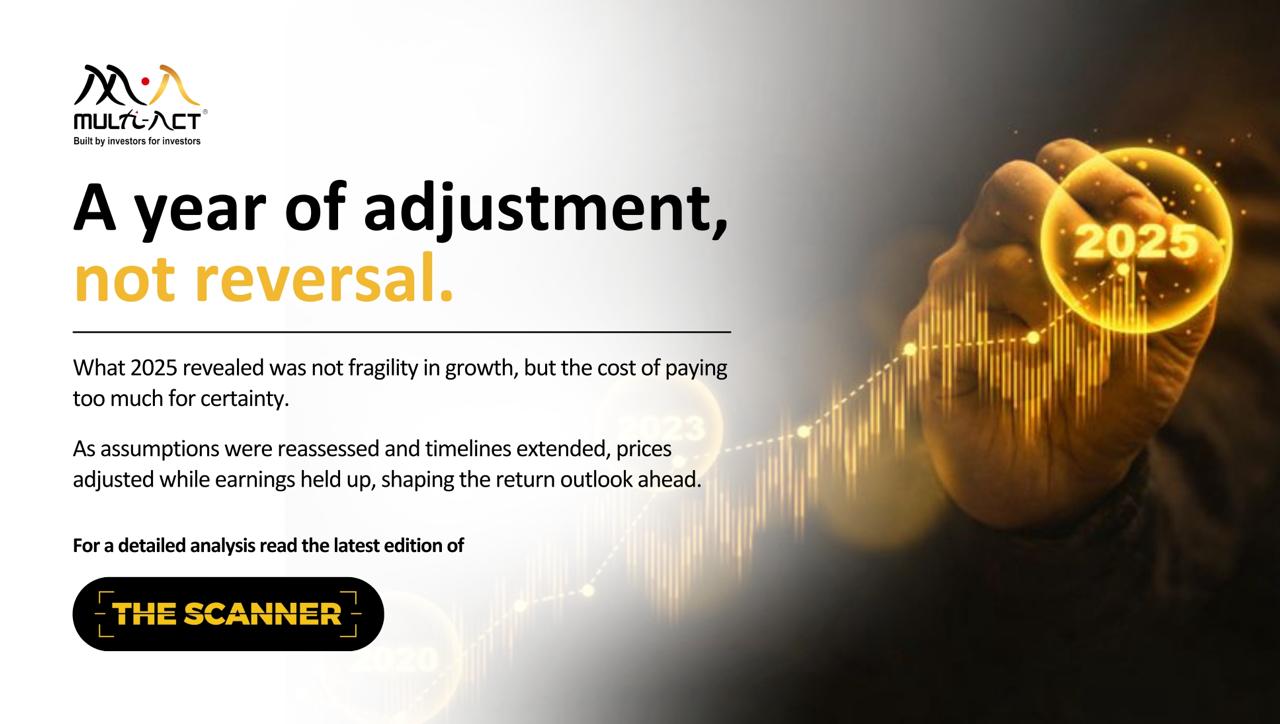
What Happened and What’s in Store for 2026
2025 did not challenge growth. It challenged assumptions. As expectations moved ahead of actual delivery, prices adjusted … Continued
Read more12 October 2018

If you follow cricket, you would be aware of terms like “high or low-scoring ground or pitch”. Some cricket grounds are known to be favourable for batsmen and on an average, these grounds help deliver high scores while others are known to be low-scoring grounds.
Similarly, in investing we believe valuation at the time of investing is an important variable that determines whether you are playing on a high-scoring ground (high average expected returns) or a low-scoring ground (low average expected returns).
The returns you generate in equities is a factor of three key variables.
At the time of investing, the only variable that you know for sure is the valuation multiple that you are currently paying while you can only make assumptions for the other two variables. The question is, does the valuation at the time of investing have any bearing on future returns? Can it tell you whether you are playing on a high-scoring ground or on a low-scoring ground?
Let’s look at historical SENSEX data to ascertain how future returns have behaved based on the valuation multiple that would have been paid at the time of investing. We have kept the analysis at a broader market level; as an individual investor, your returns could have been better or worse based on your skill and your luck.
We used monthly SENSEX PE and price data (from June 1995 – Sep 2018) and then broke the starting PE (Price/EPS) valuation (as per BSE) at the time of investing into 5 buckets (less than 15x PE, 15x – 17.5x, 17.5x – 20x, 20 – 22.5x and more than 22.5x PE). We then calculated a 3-year CAGR of SENSEX from that point and compared it with the starting PE valuation (in other words, the 3 year CAGR you would have generated going forward based on PE valuation at the time of investment). We have then taken the average and median of returns in each of the PE buckets. The chart below summarises the results.

The chart clearly shows what one would imagine intuitively – the three year average returns are higher in the lower PE bucket when valuations at the time of investing are relatively cheaper. The average returns are lower in the higher valuation buckets when your starting point is in an expensive market. But let’s dissect these numbers further to understand the probabilities and risks involved.
First, let’s look at the probability of making money (positive return) in each valuation bucket. This table summarises the probabilities.

The probability that you made money in the three year period is high across the buckets. Even in the PE valuation bucket of above 22.5x, 67% probability of making money is not bad. But if we look at the average gain (CAGR) when the returns were positive we can see the divergence. In the lower/cheaper valuation buckets not only is the probability of making a positive return higher, but the average gains are also high – and the best three year periods had mind-boggling CAGRs. While at the expensive end, not only is the probability of making a positive return relatively lower, the average gain is below the risk-free rate and the best three-year return just matches the risk-free rate. Thus even if you have been really lucky, the returns would not have been so respectable if you had invested in an expensive market.
Now let’s look at the risk angle. This table summarises the probability that you lost money in the three year period.

Investing in a cheaper market does not completely protect you from the probability of loss. As can be seen from the table above, there is still a minor probability of loss even if you invest in a cheap market. The probability of loss goes up further as we look at the expensive buckets.
But the average loss (CAGR) whenever you lost money is very low or manageable in the cheaper buckets, while average loss (CAGR) is high as you move to the expensive buckets. If you were really unlucky and had to face the worst case of loss in the three-year period, you would have still faced a relatively manageable loss in the lower valuation buckets as compared to -15.5% CAGR (i.e. 40% capital loss!) in the expensive bucket.
Essentially the historical data suggests that odds are in your favour when markets are in the cheaper buckets and you have to be really unfortunate to not make money. Essentially you are playing on a high-scoring ground.
However, if the markets are expensive, the odds are against you. Your luck would have to do the extra work to make, at best, the risk-free rate.
As investors in equities, we cannot keep a smooth, linear expectation of returns. We must learn to adjust our expectations based on the ground that we are playing on.

2025 did not challenge growth. It challenged assumptions. As expectations moved ahead of actual delivery, prices adjusted … Continued
Read more
Macro numbers alone rarely tell the full story. When jobs, consumption, credit, and inflation are considered together, … Continued
Read more
The AI story everyone sees is technological. The story that a few notice is financial. Revolving expenditures, … Continued
Read moreReceive monthly updates by signing up to our newsletter.
|
Sr. No. |
Received from |
Pending at the end of last month |
Received |
Resolved* |
Total Pending # |
Pending complaints > 3 months |
Average Resolution time^ (in days) |
|
1 |
Directly from Investors |
0 |
0 |
0 |
0 |
0 |
0 |
|
2 |
SEBI (SCORES) |
0 |
0 |
0 |
0 |
0 |
0 |
|
3 |
Other Sources (if any) |
0 |
0 |
0 |
0 |
0 |
0 |
|
|
Grand Total |
0 |
0 |
0 |
0 |
0 |
0 |
Number of complaints received during month against the IA due to impersonation by some other entity:
Note: In case of any complaints received against the IA due to impersonation of the IA by some other entity, the IA may adjust the number of such complaints from total number of received/resolved complaints while preparing the above table. Further, IA must close such impersonation related complaints after following the due process as specified by SEBI/ IAASB.
* Inclusive of complaints of previous months resolved in the current month.
# Inclusive of complaints pending as on the last day of the month
^ Average Resolution time is the sum total of time taken to resolve each complaint in days, in the current month divided by total number of complaints resolved in the current month.
|
Sr. No. |
Month |
Carried forward from previous month |
Received |
Resolved* |
Pending# |
|
1 |
April, 2025 |
0 |
0 |
0 |
0 |
|
2 |
May, 2025 |
0 |
0 |
0 |
0 |
|
3 |
June, 2025 |
0 |
0 |
0 |
0 |
|
4 |
July, 2025 |
0 |
0 |
0 |
0 |
|
5 |
August, 2025 |
0 |
0 |
0 |
0 |
|
6 |
September, 2025 |
0 |
0 |
0 |
0 |
|
7 |
October, 2025 |
0 |
0 |
0 |
0 |
|
8 |
November, 2025 |
0 |
0 |
0 |
0 |
|
|
Grand Total |
0 |
0 |
0 |
0 |
*Inclusive of complaints of previous months resolved in the current month. #Inclusive of complaints pending as on the last day of the month.
|
SN |
Year |
Carried forward from previous year |
Received |
Resolved* |
Pending# |
|
1 |
2021-22 |
0 |
0 |
0 |
0 |
|
2 |
2022-23 |
0 |
0 |
0 |
0 |
|
3 |
2023-24 |
0 |
0 |
0 |
0 |
|
4 |
2024-25 |
0 |
0 |
0 |
0 |
|
|
Grand Total |
0 |
0 |
0 |
0 |
*Inclusive of complaints of previous years resolved in the current year. #Inclusive of complaints pending as on the last day of the year.